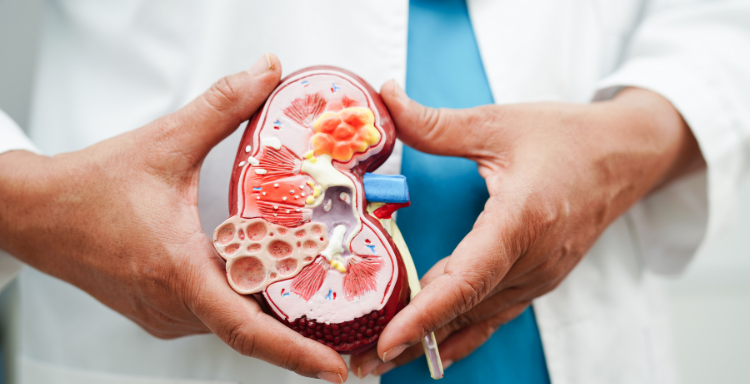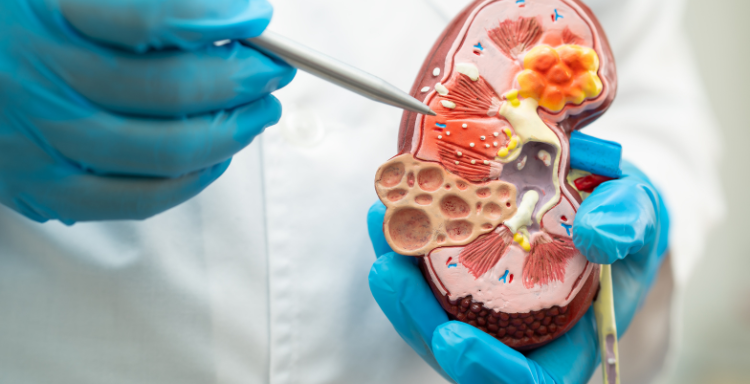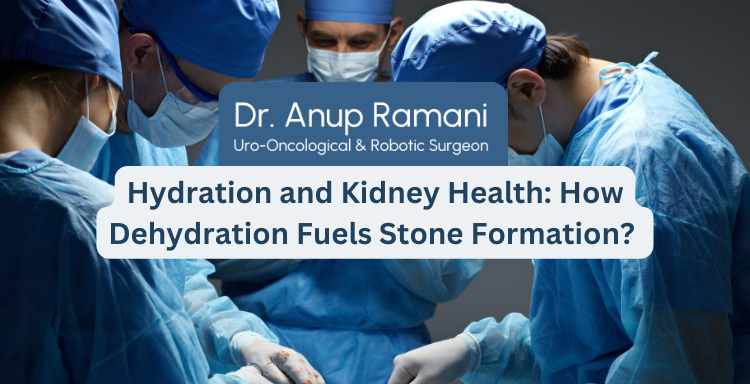Dr Anup Ramani @ Copyright 2024
By Dr. Anup Ramani
The kidneys are essential organs responsible for filtering waste, balancing fluids and regulating blood pressure. They remove toxins and excess minerals from the bloodstream and ensure the body maintains proper hydration. However, one of the most common kidney-related health problems is the formation of kidney stones, which occur when minerals and salts accumulate and crystallize inside the kidneys.
A major contributing factor to kidney stone formation is dehydration. When the body does not receive enough fluids, urine becomes concentrated, creating an environment where minerals can bind together and form solid masses. These stones can range in size from tiny grains to larger structures that block the urinary tract, causing intense pain and complications.
This article explores the connection between hydration and kidney function, how dehydration contributes to stone formation, its risk factors and preventions, including medical and surgical interventions.
Role of Water in Kidney Function
Water is essential for kidney function because it helps remove waste products and maintain the right balance of minerals and electrolytes in the body. Drinking sufficient fluids prevents the accumulation of substances that can lead to kidney stone formation. Proper hydration ensures that:
- Urine is diluted, preventing high concentrations of minerals.
- Waste products and toxins are efficiently expelled from the body.
- The balance of calcium, oxalate and uric acid remains stable, reducing the likelihood of crystallization.

How Dehydration Contributes to the Formation of Kidney Stones?
When the body lacks adequate water, urine becomes more concentrated, increasing the risk of stone formation. The minerals that should have been flushed out remain in the kidneys, where they can clump together and form solid deposits. Key factors that contribute to stone development include:
- Calcium oxalate, which is the most common component of kidney stones.
- Uric acid, which accumulates in the urine when individuals consume high-purine foods such as red meat, shellfish and alcohol.
- Phosphate and cystine, which contribute to stone formation in people with specific metabolic conditions.
Individuals who do not drink enough water are at a greater risk of developing kidney stones, as their urine lacks the volume needed to dissolve and carry away excess minerals.
The Silent Growth of Kidney Stones
Kidney stones develop gradually and many people do not realize they have them until the stones grow large enough to cause discomfort. In the early stages, stones may remain in the kidneys without interfering with urine flow, making detection difficult.
Why Symptoms do not Appear Immediately?
- Small kidney stones can pass through the urinary system without any pain.
- Mineral deposits accumulate over time, forming larger stones before causing any noticeable symptoms.
- Pain and complications only occur when the stone moves into the ureter, the tube connecting the kidney to the bladder.
Symptoms of Kidney Stones
Once kidney stones begin to cause problems, individuals may experience:
- Sharp pain in the lower back, abdomen or sides, which may come in waves.
- Presence of blood in the urine, leading to pink, red or brown discoloration.
- Burning sensation or discomfort while urinating.
- Persistent urge to urinate, often with reduced urine output.
- Nausea and vomiting, which can accompany severe pain.
- Cloudy or foul-smelling urine, indicating infection or stagnation of waste.
Kidney stones may remain unnoticed for months or even years, only becoming a problem when they begin to block urine flow or irritate the urinary tract. If symptoms develop, medical evaluation is necessary to determine the best course of treatment.
Risk Factors That Increase the Likelihood of Kidney Stones
Certain lifestyle habits and medical conditions can further increase the risk of developing kidney stones:
- Inadequate water intake, particularly among those who consume less than two liters of fluid per day.
- Diets high in sodium, which leads to increased calcium excretion in the urine.
- Excessive consumption of caffeine and alcohol, both of which have dehydrating effects.
- Living in hot climates or engaging in intense physical activity that results in excessive sweating.
- Medical conditions such as diabetes, obesity and chronic kidney disease that impair kidney function.

Preventing Kidney Stones with Proper Hydration
To lower the risk of kidney stones, individuals should:
- Drink at least two and a half to three liters of water daily.
- Monitor urine color to ensure it remains light yellow or clear.
- Increase fluid intake during hot weather or after exercise.
- Incorporate hydrating beverages such as lemon water, which contains citric acid that helps prevent stone formation.
Hydration remains one of the most effective ways to maintain kidney health and reduce the likelihood of developing stones.
Navigating Kidney Stone Complications: When Do Kidney Stones Require Surgery?
Although hydration and dietary changes can prevent kidney stones, some cases require medical intervention when stones become too large or painful to pass naturally.
Surgical procedures may be necessary when:
- If the kidney stone is larger than 6mm and is unlikely to pass on its own.
- The stone causes severe pain and obstructs urine flow.
- Repeated urinary tract infections occur due to the presence of a stone.
- The stone leads to swelling or damage to the kidney.
Different Surgical Procedures for Kidney Stone Removal
1. Ureteroscopy and Retrograde Intrarenal Surgery
A minimal invasive procedure where a small camera is inserted through the urinary tract to locate and remove the stone.
- A laser is used to break the stone into smaller fragments.
- No incisions are made, reducing pain and recovery time.
- The procedure lasts between 40-45min.
- Patients are typically discharged the following day and can resume daily activities within a week.
2. Percutaneous Nephrolithotomy
Used for larger stones that cannot be broken down through non-invasive methods.
- A small incision is made in the back to allow direct removal of the stone.
- Recovery time is slightly longer, with a hospital stay of 2-3 days.
3. Extracorporeal Shock Wave Lithotripsy
A non-invasive method that uses sound waves to break stones into smaller pieces.
- Most effective for stones under 2cm in size.
- May require multiple treatment sessions to achieve full stone removal.
4. Cost of Kidney Stone Surgery in India
- Kidney stone laser treatment costs vary based on hospital and procedure type.
- Advanced laser procedures are more cost-effective compared to traditional open surgeries, making them a preferred choice for many patients.
Conclusion
Hydration plays a critical role in preventing kidney stone formation. Without adequate fluid intake, urine becomes concentrated, allowing minerals to crystallize and form stones. While proper hydration and dietary adjustments can prevent many cases of kidney stones, some individuals will still require medical or surgical intervention to remove existing stones.
For patients experiencing severe kidney stone complications, minimal invasive procedures such as ureteroscopy, retrograde intrarenal surgery and laser treatments offer effective solutions with minimal recovery time. Advances in kidney stone removal techniques have made treatment safer and more accessible.
Dr. Anup Ramani, a highly experienced robotic surgeon, specializes in kidney stone removal procedures and has extensive experience in minimal invasive surgical techniques. With over two decades of experience in robotic surgery, Dr. Ramani is dedicated to providing patients with the highest quality of care, ensuring a comprehensive understanding of their condition and treatment options. His patient-focused approach allows individuals to feel confident in their treatment plan, leading to better outcomes and faster recovery.
FAQs About Hydration and Kidney Health
1. What are the first signs of kidney stones?
Early signs include discomfort in the lower back, frequent urination and changes in urine color. As stones grow larger, they can cause sharp pain and other severe symptoms.
2. How much water should I drink to prevent kidney stones?
It is recommended to drink at least 3 Liters of water daily. Staying hydrated helps dilute urine and reduces the risk of stone formation.
3. Is kidney stone surgery painful?
Minimal invasive procedures such as ureteroscopy and retrograde intrarenal surgery are performed under anaesthesia, ensuring a pain-free experience and quick recovery.
4. How long does recovery take after kidney stone surgery?
Most patients can resume normal activities within a week. Heavy activities such as running and weight lifting can typically be resumed after a month.
Read More Articles on Kidney Stone
About Author

Uro-Oncological & Robotic Surgeon
Dr. Anup Ramani is a robotic uro-oncological surgeon and an internationally recognized expert in robotic surgery for prostate, kidney and urinary bladder cancers. With more than two decades of robotic experience and 2,000+ robotic procedures, he brings unmatched precision and outcomes to complex uro-oncology cases. He is widely published in his field and is known for a personal, transparent approach-often spending over an hour in initial consultations to educate patients on its disease, surgery and recovery. His expertise spans prostate cancer treatment, kidney and bladder cancer surgery, adrenal gland surgery, kidney stone treatment, penile cancer surgery and enlarged prostate management. Dr. Ramani advocates the advantages of robotic surgery-magnified 3D vision, tremor-filtered precision, minimal scarring, lower blood loss and faster recovery-helping patients return to life sooner.
Table of Contents
Recent Blogs
Best Uro-Oncological surgeon
Specialist in India for Robotic Surgery
MCh, DNB, MS, DNB
Dr. Anup Ramani
CONTACT
Uro-Oncologist in India,
Best Robotic Surgeon for Uro Oncology Surgery
1407, One Lodha Place Next to World Towers Senapati Bapat Marg, Worli, Mumbai. 400013.
Dr Anup Ramani @ Copyright 2024 – Website Maintenance, SEO & GEO by Opal Infotech
- Partial penectomy is done in cases where glans and distal penis is involved with carcinoma.
- Partial penectomy is a type of organ-preserving surgery. Preservation of sexual and micturational function depends on the surgical dissection and reconstruction of residual urethra.
- Patients who develop stones in the kidney or ureter, often experience severe pain.
- This condition usually needs a procedure to remove the kidney stones.
- This procedure is called ureteroscopy and is performed very commonly.
- It does not require any cuts and hence it is painless.
- The procedure is performed with an endoscope inserted through the penis under spinal anesthesia.
- The scope is inserted through the penis into the kidney and stones are dissolved with a laser.
- The procedure takes about 40-50 minutes.
- A catheter (urine pipe) is kept after the procedure to drain the bladder. A stent is kept in the kidney at the same time.
- Patient is mobile and walking in the room the same evening.
- Hospital stay is one night and patient is discharged the next day after removal of the catheter.
- Patient has to come back after six weeks to remove the stent in the kidney.
- Patients can resume office a week after surgery and heavy activities like running, weight lifting, a month after the procedure.
- We offer fixed packages for this procedure which can be obtained by calling our helpline +91 9967666060.
- Men with an enlarged prostate, which is a normal ageing changes, often experiencing difficulty passing urine. This condition usually needs a procedure to trim the prostate and relieve the blockage.
- This procedure is called TURP and is performed very commonly.
- It does not require any cuts and hence it is painless.
- The procedure is performed with an endoscope inserted through the penis under spinal anaesthesia.
- The overgrown prostate is dissolved with a laser bloodlessly.
- The procedure takes about 40 minutes.
- A catheter (urine pipe) is kept after the procedure to drain the bladder.
- Patient is mobile and walking in the room the same evening.
- Hospital stay is two nights and patient is discharged with the catheter, which is removed after 4 days.
- Patients can resume office a week after surgery and heavy activities like running, weight lifting, a month after the procedure.
- We offer fixed packages for this procedure which can be obtained by calling our helpline +91 9967666060.
-
Robotic adrenalectomy is a sophisticated, complex surgery and it is very important that an experienced surgeon performs this surgery to avoid major complications.
-
Once the anesthesia is done, and patient positioned, three micro cuts (3mm each) are made in the patient’s abdomen.
-
The arms of the Da Vinci robot are connected to the cuts via ports (tubes).
-
Dr. Ramani then sits in the controlling console to perform the surgery.
-
On an average, a robotic adrenalectomy takes one hour.
-
The surgery is almost completely bloodless and there has never been any need to transfuse blood after surgery.
-
A urine catheter and bag to drain the bladder is inserted during surgery.
-
A tiny drain pipe may be inserted in the surgical side of the abdomen, connected to a bag.
-
Patient is kept nil-by-mouth the day of the surgery, with IV fluids. Sips of water are started the next day and solid food by day three.
-
The drain pipe, if kept, is removed in the room on day 2 after surgery.
-
The catheter is removed on day two after surgery.
-
Total hospital stay for robotic adrenalectomy is 4 nights (including night before surgery).
-
Post discharge, a doctor from the surgical team visits the patient at home/ hotel room once every day.
On the day of discharge, patient is totally self-sufficient. They are able to walk freely without any pain, dress themselves, shower, toilet and they do not need to hire any nurse or help at home. Almost all patients are back to work within 2 weeks of surgery.
Heavy activities like running, weight lifting can be resumed after a month
Follow up after an adrenalectomy is in the form of CT scans, once a year for 5 years.
Local patients usually meet Dr. Ramani after two weeks to discuss report.Outstation patients are counselled on a phone consultation.
- Dr. Ramani is one of the very few surgeons in India who has the expertise to perform a robotic surgery for bladder cancer, which includes removing the urinary bladder and reconstructing a new bladder robotically.
- Robotic radical cystectomy is an extremely sophisticated, complex surgery and it is very important that an experienced surgeon performs this surgery to avoid major complications.
- Once the anaesthesia is done, and patient positioned, six micro cuts (3mm each) are made in the patient’s abdomen.
- The arms of the Da Vinci robot are connected to the cuts via ports (tubes).
- Dr. Ramani then sits in the controlling console to perform the surgery.
- On an average, a robotic radical cystectomy with an ileal conduit takes 3-4 hours.
- The surgery is almost completely bloodless and there has never been any need to transfuse blood after surgery.
- A urine catheter and bag to drain the new bladder is inserted during surgery.
- Two tiny drain pipe in inserted in the surgical side of the abdomen, connected to a bag.
- Patient is kept nil-by-mouth for 4 days after surgery with IV supplementation of patient’s daily requirements of calories, fats, carbohydrates, proteins and electrolytes.
- The drain pipes are removed in the room on day 3-5 after surgery.
- Total hospital stay for radical cystectomy is 8 nights (including night before surgery).
- Post discharge, a doctor from the surgical team visits the patient at home/ hotel room once every day.
- On the day of discharge, patient is totally self-sufficient. They are able to walk freely without any pain, dress themselves, shower, toilet and they do not need to hire any nurse or help at home.
- Almost all patients are back to work within 6 weeks of surgery. Heavy activities like running, weight lifting can be resumed after two months.
Follow up after a radical a cystectomy is in the form of CT scans, once a year for 5 years.
Histopathology report: Local patients usually meet Dr. Ramani after two weeks to discuss report.
Outstation patients are counselled on a phone consult. Depending on the report, patient may or may not need chemotherapy after surgery.
If chemo is needed, patients may choose to get it done with a medical oncologist of their choice or avail the services of one of the four medical oncologists on our team.
- Robotic partial nephrectomy is a sophisticated, complex surgery and it is very important that an experienced surgeon performs this surgery to avoid major complications. Robotic radical (total) nephrectomy is
- relatively easier but still requires significant experience to consistently deliver results.
- Once the anaesthesia is done, and patient positioned, five micro cuts (3mm each) are made in the patient’s abdomen.
- The arms of the Da Vinci robot are connected to the cuts via ports (tubes).
- Dr. Ramani then sits in the controlling console to perform the surgery.
- On an average, a robotic radical nephrectomy takes one hour and a robotic partial nephrectomy takes about an hour and half.
- The surgery is almost completely bloodless and there has never been any need to transfuse blood after surgery.
- A urine catheter and bag to drain the bladder is inserted during surgery.
- A tiny drain pipe in inserted in the surgical side of the abdomen, connected to a bag.
- Patient is kept nil-by-mouth the day of the surgery, with IV fluids. Sips of water are started the next day and solid food by day three.
- The drain pipe is removed in the room on day 3 after surgery. The catheter is removed on day two after surgery.
- Total hospital stay for radical/partial nephrectomy is 4 nights (including night before surgery).
- Post discharge, a doctor from the surgical team visits the patient at home/ hotel room once every day.
- On the day of discharge, patient is totally self- sufficient.
- They are able to walk freely without any pain, dress themselves, shower, toilet and they do not need to hire any nurse or help at home.
- Almost all patients are back to work within 2-3 weeks of surgery.
- Heavy activities like running, weight lifting can be resumed after a month.
- Follow up after a radical/partial Nephrectomy is in the form of CT scans, once a year for 5 years.
- Local patients usually meet Dr. Ramani after two weeks to discuss report.
- Outstation patients are counselled on a phone consultation.







